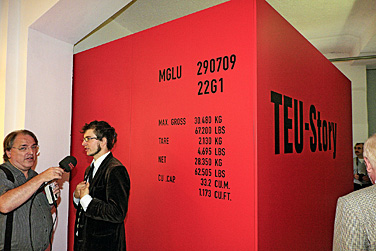Students Steer the Museum der Deutschen Binnenschifffahrt into the Future
(sf) With the latest exhibition by students from the Department of Media with the support of Prof Dr Günther Witte the Museum der Deutschen Binnenschifffahrt in Duisburg finally arrived in the 21st century: since 12 August 2009 a multimedia installation has allowed visitors to experience the handling of containers which affects the world of goods ever more increasingly.
Just like a giant container, the red exhibition unit stands in a corner of the museum. But when visitors enter inside they are surprised by an enormous dynamic: four screens deliver spectacular pictures of a normal day in a container terminal in Duisburg harbour. Crates are unloaded here extremely quickly though the use of many small sections. The filmed documentary shows a 24-hour extract from the daily harbour routine. To which are added the sound of a refined mix of of music and harbour noises. Three of the four screens, side by side, explain the magic word of modern goods transport: trimodality. In the walk-in container the visitor experiences the connection of the three transport methods water, road and rail in a multimedia way. The team of nine thereby show the actual situation. For in Duisburg, the largest inland harbour in Europe, all three methods are part of the every life.
“TEU Story” is what the creators of this exciting project have called it. TEU (Twenty-foot Equivalent Unit) is the measurement for container handling. From 2007 to 2009 they worked on this particular “story”, spent nights photographing from the container crane, and combined orchestra recordings and the original sound of the terminal into an artistic sound experience.
This cooperation between the media department and the museum is not the first. Prof Günther Witte and his students are able to look back on different joint exhibitions, among others the one for the “Boot”, the world's largest water sports exhibition in Düsseldorf.
Museum boss Heinrich Kemper is happy about the “Harbour of the Future” moving onto his premises, as up until now the historic documentation only went up until the 1970's. But through the support of the Duisburger Hafen AG (duisport) and cooperation with Duesseldorf University of Applied Sciences, the documentation has been brought up to date.
